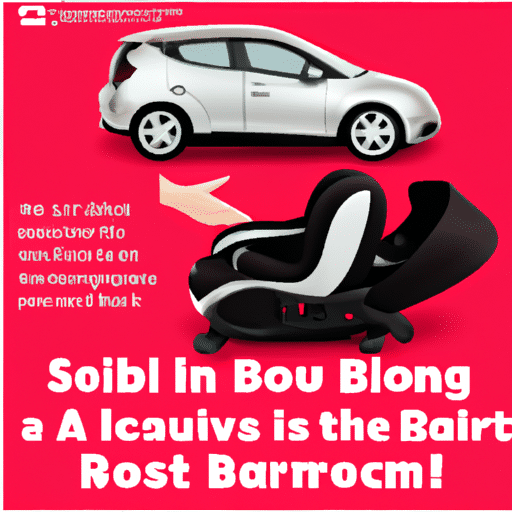When it comes to keeping your little one safe in the car, one of the most important decisions you’ll make is where to put their car seat. Ensuring that it is properly installed and positioned can prevent serious injuries in the event of a collision. In this article, we will explore the different options for placing a baby car seat in a vehicle, highlighting the key factors to consider for maximum safety and comfort. Whether you’re a new parent or simply in need of a refresher, read on to discover the best placement for your baby’s car seat.

1. Rear-Facing or Forward-Facing
1.1 Choosing between Rear-Facing and Forward-Facing
When it comes to choosing between rear-facing and forward-facing car seats, safety should be your top priority. Rear-facing car seats are designed to provide optimal protection for infants and young children. Research has shown that rear-facing car seats significantly reduce the risk of injury in the event of a collision, as they distribute the forces of impact across the child’s entire body. On the other hand, forward-facing car seats are suitable for older children who have outgrown the rear-facing position.
1.2 Benefits of Rear-Facing Car Seats
Rear-facing car seats offer numerous benefits for your child’s safety. Firstly, they provide better support for the head, neck, and spine, which are still developing in infants and young children. By facing the rear, the car seat absorbs most of the crash forces, minimizing the potential for serious injuries. Additionally, in the event of a front-end collision, rear-facing car seats help to prevent the child’s head from being thrown forward, reducing the risk of head and neck injuries. It’s recommended that children stay in a rear-facing position for as long as possible, typically until they reach the maximum height or weight limit specified by the car seat manufacturer.
1.3 Benefits of Forward-Facing Car Seats
While rear-facing car seats are generally considered to be safer for young children, there comes a point when transitioning to a forward-facing car seat becomes necessary. Forward-facing car seats provide increased comfort and visibility for older children. They also allow the child to interact more easily with their surroundings and the other passengers in the vehicle. It’s important to note that the decision to switch to a forward-facing car seat should only be made once your child has outgrown the height and weight requirements of the rear-facing position.
2. Rear Seat
2.1 Middle Rear Seat
The middle rear seat is often considered the safest position in a vehicle for a car seat. Placing the car seat in the middle seat helps to reduce the risk of side-impact collisions, as the child is farther away from the doors. The middle seat also provides a more even distribution of crash forces in the event of an accident. However, not all vehicles have a designated middle seat or have the necessary safety features, such as LATCH (Lower Anchors and Tethers for Children) attachments, to secure a car seat properly. Therefore, it’s essential to consult your vehicle’s owner’s manual and the car seat’s instruction manual to ensure proper installation and compatibility.
2.2 Side Rear Seat
If the middle rear seat is not available or suitable for installing a car seat, the side rear seat is the next best option. Both the left and right side rear seats can accommodate car seats, but it’s important to choose the side that allows for a secure installation. Look for LATCH attachments or a seat belt system that can properly secure the car seat. Keep in mind that, in some situations, one side may be easier to access and install the car seat than the other, so take this into consideration when deciding where to place the car seat.
3. Front Seat
3.1 Benefits of Placing Car Seat in the Front Seat
Placing a car seat in the front seat may seem convenient, especially for easy access to your child. However, it is generally not recommended for several safety reasons. One benefit of using the front seat is the ability to keep a close eye on your child and tend to their needs more easily. Some parents may also prefer to have their child within arm’s reach while driving. However, the potential risks associated with placing a car seat in the front seat outweigh these benefits.
3.2 Safety Concerns with Front Seat Placement
The primary safety concern with placing a car seat in the front seat is the proximity to the airbags. Front passenger airbags are designed to protect adults in the event of a crash but can be highly dangerous for infants and young children. Airbags deploying at high speeds can cause severe injuries or even death to a child in a car seat. Additionally, a car seat installed in the front seat may not be as secure or well-protected in the event of a crash compared to the rear seat. Therefore, it is crucial to follow the car seat manufacturer’s instructions and any laws or regulations in your country or state regarding car seat placement.
4. Single Car Seat
4.1 Installing a Car Seat in the Rear Seat
Installing a car seat in the rear seat is the safest option for single car seat use. To ensure proper installation, carefully read the car seat manufacturer’s instructions and your vehicle’s owner’s manual. Start by checking if your vehicle has LATCH attachments or a seat belt system for securing the car seat. LATCH attachments are typically found in newer vehicles and make it easier to install car seats securely. If your vehicle doesn’t have LATCH attachments, you can secure the car seat using the seat belt system. Remember to tighten the seat belt properly and ensure there is minimal movement of the car seat once installed.
4.2 Installing a Car Seat in the Front Seat
As mentioned earlier, installing a car seat in the front seat is generally not recommended due to safety concerns. However, if placing the car seat in the front seat is the only option available, it’s essential to take extra precautions. Make sure to disable the passenger-side airbag before installing the car seat. Consult your vehicle’s owner’s manual for instructions on how to deactivate the airbag. Additionally, always check the car seat’s manual to ensure it is suitable for front seat installation. Remember, the rear seat is the safest place for a car seat, so placing it in the front seat should only be done when absolutely necessary.

5. Multiple Car Seats
5.1 Installing Multiple Car Seats in the Rear Seat
Installing multiple car seats in the rear seat can be challenging but is certainly possible with proper planning. Start by checking if your vehicle has enough space to accommodate multiple car seats. Consider the width of the car seats and the space available in the rear seat. It’s important to ensure there is enough room for each car seat to be properly installed and securely fastened. Follow the car seat manufacturer’s instructions and consult your vehicle’s owner’s manual for specific guidelines on installing multiple car seats.
5.2 Installing Multiple Car Seats in the Front Seat
Installing multiple car seats in the front seat is generally not recommended due to safety concerns, especially with the presence of airbags. Placing car seats in the front seat increases the risk of injury in the event of an accident, as children are closer to the airbags and may be exposed to greater forces during deployment. If you have multiple car seats and cannot safely install them in the rear seat, consider using a larger vehicle or seeking advice from a certified car seat technician to ensure the proper installation of multiple car seats.
6. Car Seat Placement Tips
6.1 Checking the Car Seat Manual
Always consult the car seat manufacturer’s manual for specific instructions on installation and proper use. Each car seat has different requirements and recommendations, including height and weight limits, installation methods, and positioning.
6.2 Considering Vehicle Type
Different vehicle types have different configurations, which can impact car seat placement. For example, some vehicles have narrower rear seats that may make it challenging to install car seats side by side. Consider the dimensions of your vehicle’s rear seat and how they align with the car seat(s) you plan to use.
6.3 Avoiding Placing Car Seat Near Airbags
Ensure that no car seat is placed in a seating position where it is directly in front of an airbag. This applies to both the front seat and the rear seat. Airbags are designed to protect adults in the vehicle, and placing a car seat too close to an airbag can cause serious injuries to a child if it deploys.
6.4 Determining the Best Position for the Car Seat
Choose the seating position in the vehicle that allows for the most secure and properly installed car seat. This may involve considering factors such as vehicle design, LATCH availability, and access to the car seat from outside the vehicle.
6.5 Harnessing the Car Seat Properly
Properly harnessing the car seat is crucial for ensuring your child’s safety. Follow the car seat manufacturer’s instructions on how to correctly position and tighten the harness straps to ensure a snug fit. Check the straps regularly to ensure they are not twisted or too loose.

7. Car Seat Safety Guidelines
7.1 Ensuring a Snug Fit
A properly installed car seat should not move more than one inch in any direction when tested at the belt path. Regularly check the car seat’s installation and tighten it if necessary to maintain a secure and snug fit. Loose or improperly installed car seats can increase the risk of injury in the event of a collision.
7.2 Using the Correct Harness Slots and Straps
As your child grows, make sure to adjust the car seat’s harness slots and straps accordingly. The harness straps should be at or just below your child’s shoulders when rear-facing, and at or just above your child’s shoulders when forward-facing. Using the correct slots and straps ensures proper positioning and reduces the risk of injury.
7.3 Regularly Checking the Car Seat Installation
Inspect the car seat’s installation regularly to ensure it remains secure and properly aligned. Check for any signs of wear or damage in the seat’s structure or components. If you notice any issues, contact the car seat manufacturer for guidance or consider replacing the seat if necessary.
7.4 Conducting an Annual Car Seat Check
Consider having a certified car seat technician inspect your car seat’s installation and functionality at least once a year. These professionals can assess whether your car seat meets the safety requirements and provide guidance on any necessary adjustments or replacements.
7.5 Registering the Car Seat with the Manufacturer
Register your car seat with the manufacturer to ensure you receive important safety updates and recall information. This allows the manufacturer to directly notify you of any potential issues or necessary repairs, ensuring the continued safety of your child.
8. Traveling in Taxis or Public Transportation
8.1 Laws and Regulations for Car Seats in Taxis
Laws and regulations regarding car seat use in taxis vary by jurisdiction. Some cities or countries may require the use of car seats in taxis, while others may not. It’s essential to research the specific laws and regulations in your area before traveling with your child in a taxi.
8.2 Options for Car Seat Use in Taxis
If car seat use is not required or feasible in a taxi, there are alternative options to ensure your child’s safety. Portable travel car seats or FAA-approved child safety harnesses can be used as alternatives in these situations. These options provide some level of protection for your child, although they may not offer the same level of safety as a properly installed car seat.
8.3 Using Car Seats in Public Transportation
When using public transportation, such as buses or trains, it may not be possible to use a car seat. In these situations, you can still take steps to ensure your child’s safety. Hold your child securely or use a lightweight, collapsible stroller that provides some form of restraint. Always be mindful of your child’s safety and stay seated or hold them securely to prevent accidents or injuries during the journey.

9. International Travel Considerations
9.1 Researching Car Seat Regulations by Country
If you plan to travel internationally with your child, it’s important to research the specific car seat regulations and requirements of each destination country. Laws regarding car seat use can vary significantly, so familiarize yourself with the rules and ensure compliance to protect your child’s safety.
9.2 Using a FAA-Approved Car Seat for Air Travel
When flying with a child, using a FAA-approved car seat is highly recommended. These car seats are specifically designed to meet the safety standards required for use on aircraft. They provide an added layer of protection for your child during takeoff, landing, and turbulence. Consult the airline’s guidelines and policies to ensure proper use and installation of the car seat during the flight.
10. Conclusion
Choosing the right car seat and knowing where and how to install it is crucial for your child’s safety while traveling. Rear-facing car seats provide optimal protection for infants and young children, while forward-facing car seats are suitable for older children who have outgrown the rear-facing position. The middle rear seat is often considered the safest position in a vehicle for a car seat, but the side rear seats can also be used if installed properly. Placing a car seat in the front seat is generally not recommended due to safety concerns, particularly the proximity to airbags. Proper installation, regular checks, and adherence to car seat safety guidelines are essential to ensure your child’s safety. When traveling in taxis or public transportation, research the laws and regulations regarding car seat use, and consider alternative options if necessary. For international travel, familiarize yourself with each country’s car seat regulations and consider using a FAA-approved car seat for air travel. By prioritizing your child’s safety and following these guidelines, you can provide them with a secure and protected journey.






